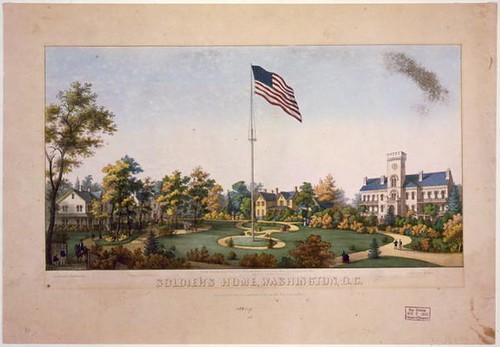By Morgan Little
The work of Charles Magnus (1826-1900) ranges from patriotic envelopes emblazoned with images of American eagles, soldier’s camp scenes, the star spangled banner and other pro-Union propaganda, to cards adorned with images of Confederate officers. Some of Magnus’s most memorable works are his large, full-color lithographs depicting places in Civil War Washington, D.C.
Three of Magnus’s lithographic prints currently on view in the President Lincoln’s Cottage Robert H. Smith Visitor Education Center allow visitors to experience historical views of the capital from a critical period of our Nation’s history. Magnus documented permanent structures and the numerous temporary barracks, depots, and hospitals that were rapidly erected in the capital to serve the war effort.
The Civil War stirred a great demand for color lithographs, used as propaganda, and more popularly, as documentary prints depicting contemporary events – Civil War camps, battles, and portraits of military officials. Maps and city views satisfied 19th century Americans’ fascination with the “physical details of their rapidly expanding country.”
In response to high demand, Magnus produced over a thousand color lithographs, created through a revolutionary printing process created by German Alois Senefelder in the 1790’s. To produce a color lithograph, an image was drawn with a greasy crayon on a piece of limestone (often by a individual lithographic artist), wet with water, inked with an oil-based ink to attract the grease (a color artist might place the colors), and then transferred to paper pressed against the stone. Through re-inking, multiple copies could be made utilizing the original image on the stone, and voila – simple, cheap, mass-produced, color reproduction was born. In Magnus’ heyday, the 1860’s, steam powered presses allowed for an even more efficient printing process.
Though Magnus’s name appears on all of his work, he probably created little of his own artwork, instead focusing his efforts on the business aspects of his printing company, while contracting out the lithographic work to men he presumably never gave credit.
Having emigrated from Germany, the birthplace of the color lithograph, after the failed political revolution of 1848, Charles Magnus and thousands of other European lithographers (here used to refer to both lithographic artists, printers and publishers), found opportunity for printmaking in the United States, where the demand for prints equated to demand for their lithographic skills; they were paid about pay about 3 to 4 times as much in the U.S. as back home.
Magnus’s signature style is represented by patriotic iconography and a repetition of images and decorations which he incorporated in a vast array of maps, city views, letterheads and other ephemera. Magnus’ New York/Washington DC based printing company published over a thousand separate lithographed paper works which evoke the power of print as a war propaganda medium and provide the opportunity for us to make a connection with the social, political, and cultural attitudes of Civil War era 19th century America.
Come experience it for yourself! On your next trip to President Lincoln’s Cottage spend some time in the Visitor Education Center with the 19th century print collection.

